Tegallalang Rice Terraces are one of Ubud’s classic first stops for new visitors, photographers, and swing-seekers. You park along the ridge, pay a small fee, then follow paths down between the fields. This guide focuses on costs, timing, routes from Ubud or South Bali, and basic etiquette on the terraces.
About this guide
- Writer: Wayan Suadnyana, Wira Tour Bali-travel editor
- Based on morning visits to Tegallalang and chats with Wira Tour local drivers, farmers, friends, and swing operators
- Last verified: 15 November 2025 (WITA)

Quick answers: Tegallalang Rice Terraces, Ubud
What are the Tegallalang Rice Terraces?
Terraced rice valley and viewpoint about 20 minutes north of central Ubud in Gianyar, Bali.
Tegallalang Rice Terraces entrance fee
Around IDR 20,000–25,000 per person plus about IDR 5,000 for parking, paid in cash at small local posts.
Tegallalang Rice Terraces opening hours
Officially, it is about 8 am to 6 pm, with many paths opening earlier and accessible from early morning to late afternoon.
Best time to visit Tegallalang Rice Terraces
Best from May to September; visit around 6–9 am for cooler weather, softer light, and fewer crowds.
How long to spend at Tegallalang Rice Terraces
Plan 60–90 minutes on the terraces, longer if you add a swing ride or a stop at a cafe on the ridge.
Basic etiquette at Tegallalang
Stay on marked paths, avoid stepping on rice, keep noise low, and ask before taking close-up photos of farmers.
“Ingin membaca panduan ini dalam Bahasa Indonesia? Buka panduan sawah terasering Tegallalang.“
Locally, the area is also known as Ceking Rice Terrace, but most visitors call it Tegallalang Rice Terraces.
Table of Contents[Hide][Show]
- Quick answers: Tegallalang Rice Terraces, Ubud
- Are the Tegallalang Rice Terraces worth visiting?
- Why Tegallalang Rice Terraces Matter Culturally
- Understanding the climate and seasons at Tegallalang Rice Terraces
- Dining around Tegallalang Rice Terraces, Ubud
- FAQ: Tegallalang Rice Terraces, Ubud
- Concluding your visit to Tegallalang Rice Terraces, Ubud
Are the Tegallalang Rice Terraces worth visiting?
Tegallalang Rice Terraces are worth visiting if you want a rice-terrace viewpoint close to Ubud with clear paths, photo spots, and optional swings. Plan about 60–90 minutes here as part of a Ubud day trip.
If you dislike crowds or steep steps, arrive early, stay near the ridge paths, and use cafes or upper viewpoints for the views.
Why Tegallalang Rice Terraces Matter Culturally
Tegallalang is more than a photo stop. The terraces are part of Bali’s subak irrigation system, a traditional water-sharing network run by local farmer cooperatives. Along the paths, you may see farmers working, small shrines, and narrow water channels feeding the fields.
Simple donation boxes and checkpoints help maintain paths, bridges, and irrigation, so keep some small notes ready if you use a particular route or viewpoint.
For more ideas on cultural shows, classes, or village walks around Ubud, see our guide to the best things to do in Ubud.
Practical information for visiting Tegallalang Rice Terraces, Ubud
Before you go, understand how entrance fees, small tips, and nearby low-cost activities work around Tegallalang.
Tegallalang Rice Terraces entrance fee and parking

As a rough guide, expect:
- Entrance: IDR 20,000–25,000 per person (about USD 1.20–1.50, approx., checked on 15 November 2025).
- Parking: around IDR 5,000 for a car or scooter (about USD 0.30).
Pay in cash at small posts along the ridge. Amounts vary slightly between access points, so keep small notes for these community maintenance fees.
For updated entrance fees at major Bali attractions, including Tegallalang, see our Bali attraction entrance fee guide.
Tipping guide at Tegallalang’s farm terraces
Tipping is not compulsory. As a simple guideline, around IDR 20,000 in total for two people works if you stop several times or get help with photos or props like baskets or hats.
Carry small denominations so you do not need to break large bills at each post. If someone offers an extra service, agree on a small amount in advance to avoid confusion.
If you combine Tegallalang with the central Ubud stops, consider a short visit to Pura Taman Saraswati.
Other low-cost things to do near Ubud
If you stay in Ubud for a few days, combine Tegallalang with low-cost stops such as local markets, short walks, and temples to spread transport costs and add variety.
For more ideas, see our guide to affordable things to do in Ubud.
Photography guide for Tegallalang’s terraced fields
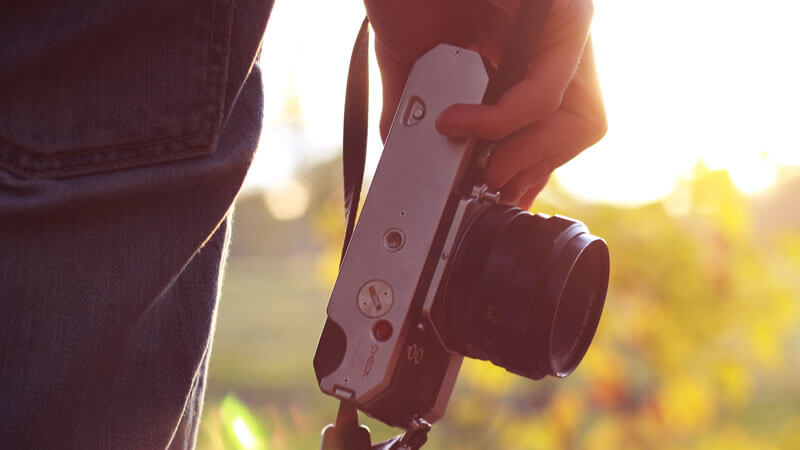
The terraces at Tegallalang are compact and layered, with paths that let you shoot from the ridge, mid-slope, or valley floor. With a bit of planning, even a phone camera can capture clear, balanced photos.
Best time of day for photos at Tegallalang
Within the 6–9 am pattern noted in Quick answers, sunrise and the first hour after, roughly 6–7 am, usually give the cleanest light and fewer crowds, so you have more time to move between angles.
Leaving Klungkung around 5 am gets me to Tegallalang by about 5.50 am, and even then, there are already photographers, pre-wedding couples, and small tour groups choosing vantage points.
If you want to explore more of Bali’s rice field scenery after Tegallalang, consider a separate trip to Jatiluwih for wider valley views and longer walks.
Best season for visiting Tegallalang Rice Terraces, Ubud
For photography, fields look most even at the height of the dry season. Outside this period, expect a mix of new planting, bright green paddies, and plots that are already harvested or flooded for the next cycle. For overall weather patterns, see the climate section above.
Equipment and simple photography techniques
You can get good photos with a phone or compact camera if you keep your hands steady and watch the light. For more control, a small mirrorless or DSLR with a basic zoom lens lets you switch between wide valley views and closer details.
If you bring a drone, check local rules, avoid flying above people or shrines, respect any no-fly signs, and keep flights short because wind can funnel along the valley.
For composition, look for leading lines such as narrow paths, water channels, or rows of rice, keep the horizon in the upper or lower third of the frame instead of the centre, and try one low angle from the path and one slightly higher angle from the ridge.
Balancing photos with the experience
After a few rounds of photos, put the camera away and walk a little farther along the paths to feel how quiet the terraces can be. If you still have energy afterwards, our one-day Ubud itinerary shows how to combine Tegallalang with Campuhan Ridge or Ubud Monkey Forest.
Adventure on the swings at Tegallalang’s terraced fields
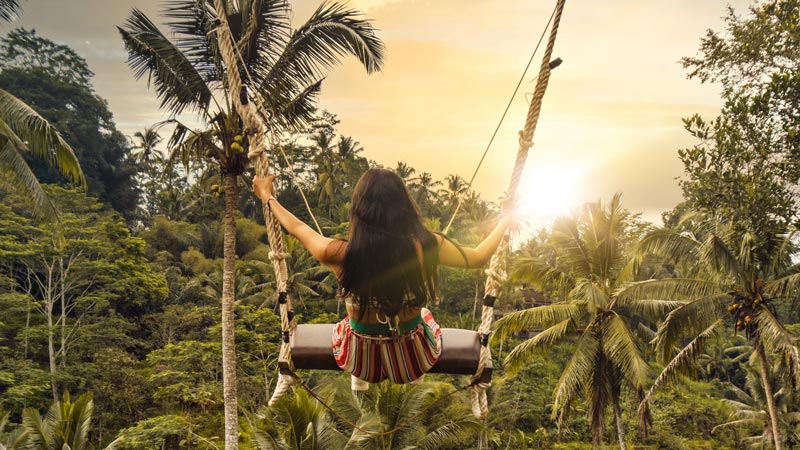
Along the ridge and near some valleys, you will find hillside swings that face the terraces, set up by cafes or swing operators for photo-focused rides.
Best swing options
Alas Harum Swing sits very close to the terraces, so your photos look as if you are “inside” the landscape rather than on the opposite side. Nearby, several other swings are attached to cafes or standalone platforms.
Walk along the ridge first, compare the views, queue length, and photo angles, then ask about prices and what is included before you choose a swing.
Safety tips and how to enjoy the swings
Before you commit, look at the platform and cables from the side. Check that safety harnesses are used and tightened properly between rides; if anything looks poorly maintained, skip that swing.
Mornings usually mean shorter queues and softer light. Common swing prices start from around IDR 100,000 per person (about USD 6, approx., checked on 15 November 2025), with extras like photo packages sometimes charged separately.
Choose a swing height that matches your comfort with heights and motion, and always follow staff instructions. As with any active experience in Bali, basic travel insurance is a useful extra layer of protection.
If you want to compare Tegallalang swings with other locations around Ubud and Bali, continue to our dedicated Bali swing guide.
Understanding the climate and seasons at Tegallalang Rice Terraces
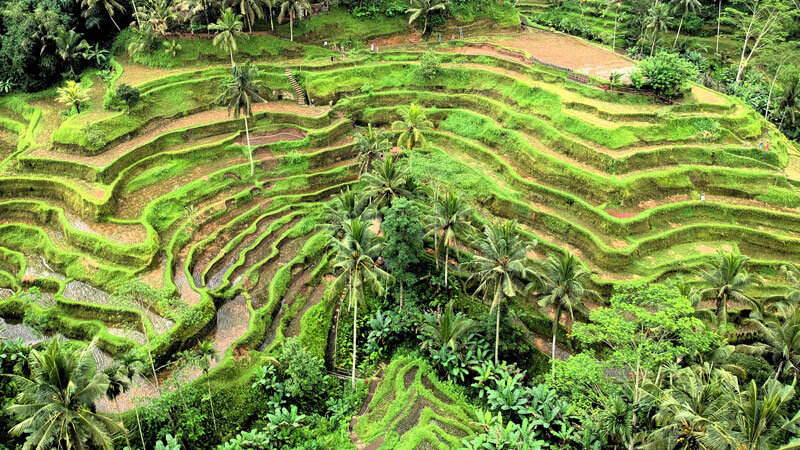
Tegallalang follows Ubud’s tropical pattern: a wetter season roughly November to March and a drier, more comfortable period around April to October. Humidity stays high all year, and sudden showers can still appear in the dry months.
In the wetter months, paths can be muddy, steps slippery, and the valley often feels cooler and mistier. In the drier months, walking is easier underfoot, but midday heat can feel intense in open sections between trees.
For an island-wide, month-by-month overview of Bali’s weather, see our guide to the best times to visit Bali.
Tegallalang Rice Terraces opening hours and daily timing tips
Tegallalang is generally accessible from early morning until late afternoon, with many listings showing official hours of about 8 am to 6 pm. Locals often allow slightly earlier access at main viewpoints.
Most visitors follow the 6–9 am window mentioned in Quick answers for cooler air, softer light, and fewer groups. Late afternoon can also be pleasant, but some paths feel busier, and the light drops quickly behind the ridge.
Tips for visiting at different times of day
If you arrive around sunrise, walk along the ridge first to see which entrances are already open, then confirm access with locals at the nearest post before heading down.
By mid-morning, allow extra time for queues at photo spots and swings. After heavy rain, wear shoes with a good grip and avoid narrow shortcuts that look muddy or eroded.
Each swing operator and restaurant sets its own hours, so check signs or ask staff if you are planning a breakfast or coffee stop with terrace views.
Walking routes and light hiking at Tegallalang
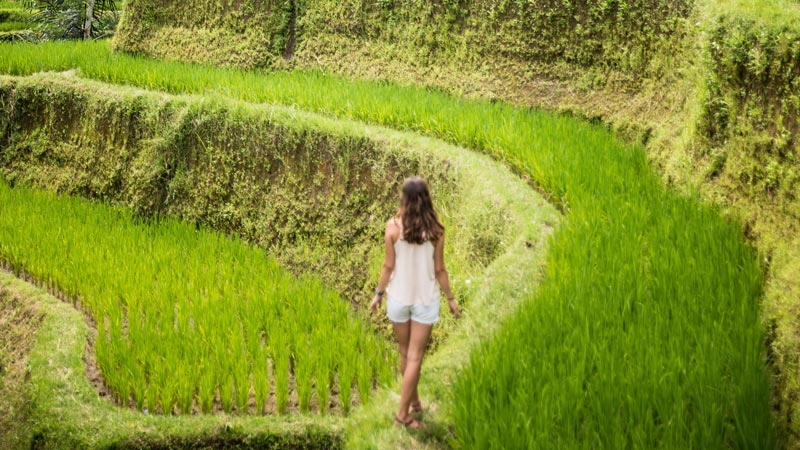
Most visitors follow a short loop: down one side of the valley, across a small bridge, and up the other side for views back to the ridge. You can turn around whenever the steps feel too steep.
For a slightly longer walk, continue along the ridge to find other stairways and small paths linking several pockets of terraces. Watch your footing, especially after rain, as some narrow sections can be muddy or uneven.
Less-used paths and when to turn back
Some side paths lead away from the main terraces towards small hamlets and farm plots. These quieter routes sit close to people’s homes and work areas, so treat them as private unless clearly signed for visitors.
If a path seems to enter a yard, pass behind a house, or cut past drying rice, turn back or ask at a donation post or cafe whether it is open to visitors.
If you want to add more adventure to your Ubud day after Tegallalang, you can consider an Ayung River rafting tour; we explain how it works in our Ayung rafting guide.
What to wear and how to behave at Tegallalang Rice Terraces

Paths are narrow, stepped, and sometimes muddy, and farmers and worshippers use the same space, so clothing and behaviour matter.
Mindful environmental awareness
Treat the terraces as both a workplace and a shared landscape. Stay on existing footpaths instead of cutting across planted sections, and avoid stepping on the edges that hold water in place.
Keep your voice low so you do not disturb people working or praying at small shrines. For close-up photos of farmers, ask politely first and accept a “no” without insisting or pointing your camera anyway.
Some terraces and paths are part of private land. If an area is roped off, marked with a sign, or feels like someone’s backyard, do not enter, move tools, or rearrange props for photos.
Suppose you still have energy after walking the terraces and returning to central Ubud. In that case, you can stop at Ubud Art Market for handmade crafts and simple souvenirs.
What to bring for visiting the Tegallalang Rice Terraces
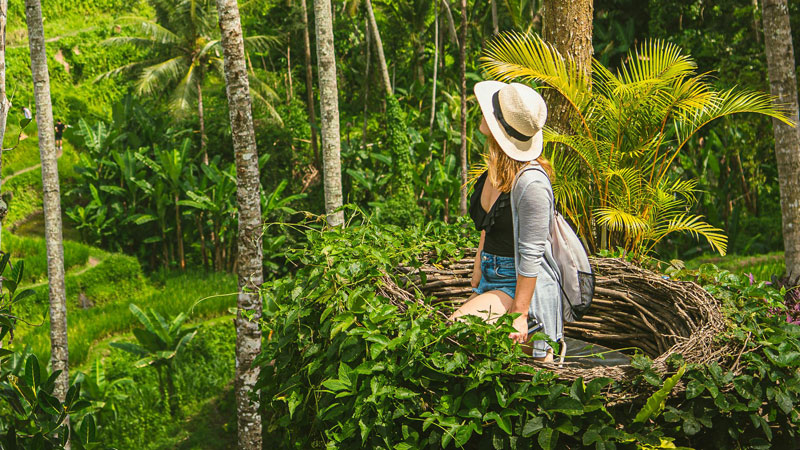
Recommended clothing and basic gear
Wear light, breathable fabrics that dry quickly, such as cotton or linen, and bring a thin extra layer in case it turns breezy. Closed-toe shoes or sturdy sandals with a good grip are safer than thin flip-flops on wet or uneven steps.
For sun protection, pack a hat and sunglasses, especially if you plan to walk to different sections of the valley. A small refillable water bottle is useful because shops can be spaced out once you leave the main ridge.
Additional preparations for the visitor experience
Charge your phone or camera before you leave and carry a small power bank. The terraces are compact but very photogenic, and batteries drain faster when you record video or use navigation apps.
During the wetter months, slip a light plastic bag or rain cover into your daypack. Showers can arrive quickly, and a simple cover helps keep electronics and wallets dry.
Facilities and services at Tegallalang’s terraced fields
Most facilities sit along the ridge and near cafe clusters facing the terraces; once you walk deeper into the valley, services are limited.
Public facilities for visitors
Basic public toilets are located near parking areas and restaurants. Some charge a small fee and may not provide paper, so bring your own tissues or wet wipes.
Along the ridge, you will find simple rest spots, small shelters, and cafe verandas where you can sit, cool down, and enjoy the view without walking further.
Emergency services and safety
There is no formal clinic inside the terraces, but cafes can often help with basic first aid, such as plasters and drinking water, if you start to feel unwell. For anything more serious, you will need to return to Ubud.
The area feels relatively safe, yet you should still watch your step on narrow edges and wet paths, especially after rain, and avoid rushing on the way back up when you are tired.
Local etiquette and customs
The terraces sit inside a village area where shrines, temples, and homes lie close together, so modest dress and calm behaviour help you blend in.
Appropriate dress code
There is no strict dress code for walking among the terraces, but clothing that covers your shoulders and at least to the knees is a considerate choice, especially if you pass shrines or meet elders on narrow paths.
Avoid swimwear, extremely short shorts, or tops that feel like beachwear. If you plan to go straight to a temple afterwards, pack a light scarf or sarong in your bag.
Tips for visiting temples and cultural landmarks nearby
At temples or other sacred sites, follow posted signs and local instructions. Many will ask you to wear a sarong and sash. They may restrict access during ceremonies or if you are not dressed appropriately.
For a fuller explanation of what to wear at Balinese temples, including photos and packing tips, see our guide to appropriate attire for visiting temples in Bali.
How to get to Tegallalang Rice Terraces from Ubud and South Bali

From central Ubud, Tegallalang Rice Terraces sit about 9 kilometres to the north, or roughly 20 minutes by car or scooter in light morning traffic.
From Seminyak, Kuta, or Canggu, expect a drive of about 30–40 kilometres and 1–1.5 hours, depending on time of day and traffic.
Routes from Ubud and the South Bali areas
From Ubud to Tegallalang
Most drivers head north from central Ubud via Jalan Tirta Tawar or Jalan Raya Tegallalang. Both routes join the main ridge road, where parking areas and viewpoints overlook the terraces.
From Seminyak, Kuta, and Canggu to Tegallalang
Meanwhile, from Seminyak or Kuta, a common route is along Jalan Sunset Road, then north through Kerobokan and onwards towards Ubud before continuing up to Tegallalang. From Canggu, you usually join the same corridor after passing through Kerobokan.
Route planning tips
Use Google Maps or another navigation app to check live conditions before you leave, especially during school and commute hours, and download the area map for offline use in case of a patchy signal around Ubud.
Leaving early in the morning usually gives a more relaxed drive and easier parking along the ridge.
If you want help fitting Tegallalang into a one-day plan, see our one-day itinerary in Ubud for suggested routes and stop order.
Scenic journey to Tegallalang’s terraced fields
Enjoy the classic Balinese landscape on your way to Tegallalang. You’ll pass green rice fields and traditional villages and may find small viewpoints where you can pause for photos. If you have extra time in your Ubud day, you can add a short stop at Goa Gajah before or after visiting the terraces.
Transport options available
Private transport: car rental with driver or day tour
Hiring a car with a driver or booking a small-group day tour is the most comfortable option for families or first-time visitors. You do not need to manage navigation, parking, or entrance discussions, and it is easy to add other Ubud stops in one loop.
Online transport: Gojek or Grab
If you are already staying in Ubud, ride-hailing apps like Gojek and Grab can be an efficient way to reach Tegallalang and return without arranging a full-day car. Check the app for pick-up points that work with one-way roads near the terraces.
Motorbike rental: for independent exploration
Renting a motorbike gives you the most freedom to explore back roads and make spontaneous stops. It’s best suited to travelers who are already confident riding in Bali’s traffic and comfortable with varying road conditions around Ubud.
For a broader look at getting around the island, see our guide to transport options in Bali.
Dining around Tegallalang Rice Terraces, Ubud
Along the ridge above the terraces, you will find cafes and restaurants serving coffee, juices, and simple meals with valley views. Some also host swings or photo platforms.
A short walk or drive away, you can find local warung (simple eateries) that serve Balinese dishes, often with both halal and non-halal options depending on the owner.
For a broader list of places to eat in town, including local favourites and simple cafes, see the Ubud food and warung guide.
FAQ: Tegallalang Rice Terraces, Ubud
Do you need a guide at Tegallalang Rice Terraces?
No. Paths are easy to follow on your own, and most drivers wait at the parking area. Some visitors hire a local to help with photos; if you do, agree on a small fee first.
Is Tegallalang or Jatiluwih better for rice-terrace views?
Choose Tegallalang if you want a quick, scenic stop near Ubud with swings and cafes. Pick Jatiluwih if you prefer wider valleys, longer walks, and fewer crowds. Many travelers visit Tegallalang on an Ubud day, then Jatiluwih on another day.
Is Tegallalang suitable for seniors or visitors who dislike steep hikes?
Yes, if you stay near the ridge. Older visitors can enjoy views from roadside cafes or upper viewpoints without climbing down. Wear sturdy footwear and avoid visiting straight after heavy rain.
Do you need to book Tegallalang swings in advance?
Usually no. Swings are paid per ride on the spot. During busy mid-morning hours, you may wait for your turn. Check harnesses and posted prices carefully before choosing a swing operator.
Concluding your visit to Tegallalang Rice Terraces, Ubud
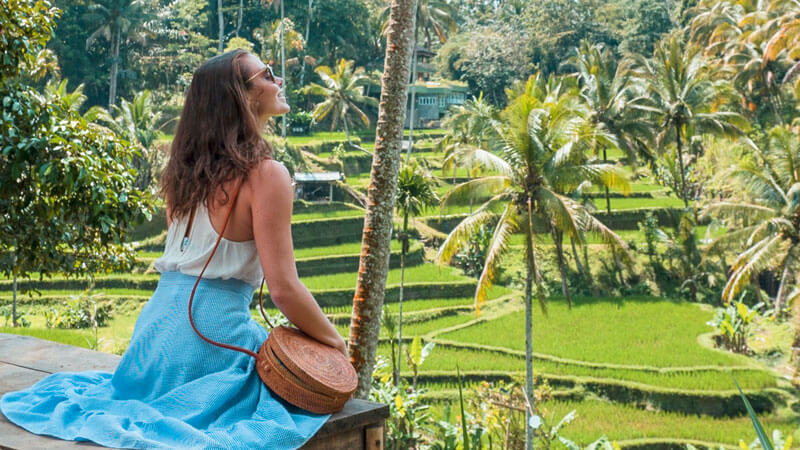
For most visitors, Tegallalang is a simple half-day highlight: travel up from Ubud, pay the entrance and parking fees, walk one or two loops between the terraces, take a few photos or a swing, then relax at a cafe on the ridge.
If you arrive early, bring water, wear shoes with grip, and respect the paths and farmers’ work. Tegallalang is one of the easiest rice-field stops to fit into a first Ubud itinerary; use this guide for the basics, then add a few other Ubud stops that suit your time and energy.

 Ubud Travel Guide: Essential Tips for First-Time Visitors
Ubud Travel Guide: Essential Tips for First-Time Visitors
We'd love to hear from you! Share your thoughts or experiences in the comments below!